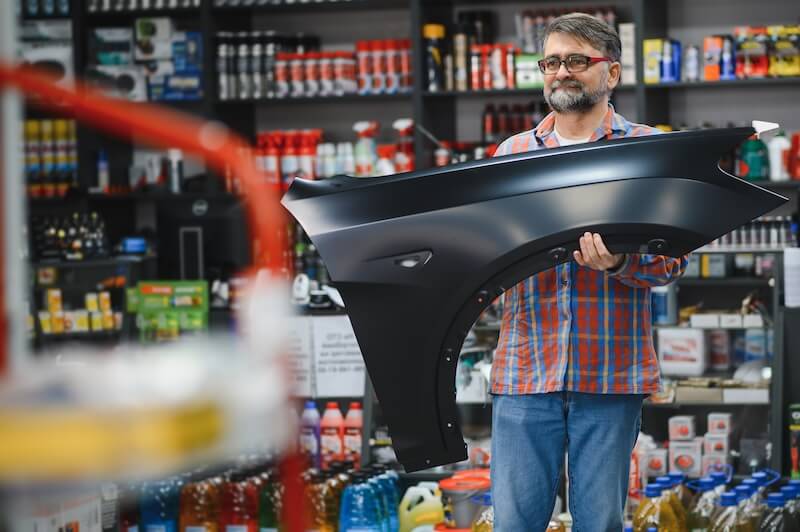When your vehicle has been in a collision, one of the first big decisions to make is what kind of replacement parts will be used during the repair. At OHS Body Shop, we get asked this question all the time: should I choose OEM parts or aftermarket parts? It might seem like a simple yes-or-no, but the reality is a bit more nuanced. Each option has its advantages and disadvantages, and your choice can impact cost, quality, warranty, and even how your vehicle performs after the repair.
So, what exactly are OEM and aftermarket parts? OEM stands for “Original Equipment Manufacturer.” These are parts made by the same company that built your car. They’re exact matches for the parts your vehicle came with from the factory—same materials, design, and fit. Aftermarket parts, on the other hand, are made by third-party companies that are not the original car manufacturer. These parts can vary widely in quality, from bargain-bin knockoffs to high-quality components designed to meet or exceed OEM standards.
The Pros of OEM Parts
OEM parts are generally considered the gold standard in collision repair. Because they come directly from the manufacturer, you can be confident the part fits perfectly and performs as intended. This is especially important for structural or safety components, where any variance in material strength or fit could affect your vehicle’s crashworthiness or handling.
OEM parts also tend to blend more seamlessly with your vehicle’s existing components. The paint match is usually perfect, and there are fewer worries about minor fitment issues like gaps or alignment problems. Plus, using OEM parts often helps preserve your vehicle’s warranty and resale value.
The Cons of OEM Parts
The downside to OEM parts is often cost. Because they come straight from the manufacturer and usually have to pass strict quality controls, they can be significantly more expensive than aftermarket alternatives. Availability can also be a factor. Depending on the make and model of your vehicle, OEM parts might have longer wait times, especially if the part is rare or specialty.
For drivers on a tight budget, this can be a challenge—especially if insurance companies push for cheaper aftermarket parts to reduce claim payouts.
The Pros of Aftermarket Parts
Aftermarket parts often cost less—sometimes significantly so. That can be a huge relief if you’re paying out of pocket or want to keep insurance premiums down. There’s also a wide range of aftermarket options. Some manufacturers produce parts that meet or even exceed OEM standards, sometimes offering improvements in design or materials.
Additionally, aftermarket parts can be easier to find, with many parts available off the shelf or through multiple suppliers, helping speed up the repair process.
The Cons of Aftermarket Parts
The biggest risk with aftermarket parts is variability in quality. Since they come from many different companies, not all parts are created equal. Some cheaper parts may use inferior materials, have poorer fit, or fail more quickly. This can result in issues like uneven panel gaps, premature wear, or even compromised safety.
Paint matching can also be a challenge with aftermarket panels, leading to a less seamless look. Some insurance companies may prefer aftermarket parts to save money, but that doesn’t always mean it’s the best choice for your vehicle’s longevity or appearance.
What We Recommend at OHS Body Shop
At OHS Body Shop, our goal is to get your vehicle back to pre-accident condition safely, reliably, and looking great. That means we carefully consider which parts to use based on your vehicle type, repair needs, budget, and insurance situation.
For critical safety components—like frame parts, airbags, or structural elements—we always recommend OEM parts. These are essential to maintaining your vehicle’s crash safety systems.
For cosmetic parts, such as fenders, bumper covers, or interior trim, we discuss with you whether a high-quality aftermarket part might be a reasonable option if cost is a concern. We only source aftermarket parts from reputable suppliers that meet strict quality standards.
Ultimately, we want you to feel confident in your repair and the parts we use. We’re transparent about costs and options upfront, so you can make the best choice for your situation.
Costs and Insurance Considerations
Insurance policies vary widely. Some will cover OEM parts fully; others push for aftermarket parts to save money. If you prefer OEM parts, it’s important to communicate that early and understand how it might affect your claim.
We work closely with insurance companies and our customers to find the best solution. Sometimes a hybrid approach makes sense—OEM for safety parts, aftermarket for less critical pieces.
Final Thoughts
Choosing between OEM and aftermarket parts after a collision isn’t just about price—it’s about your safety, your vehicle’s integrity, and your peace of mind. At OHS Body Shop, we’re here to guide Montana drivers through that decision with honesty and expertise. Whether you want the exact factory parts or high-quality aftermarket components, we’ll help you get your vehicle repaired right, the first time.

